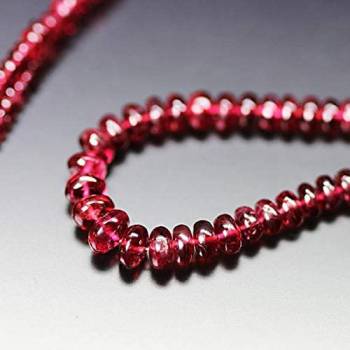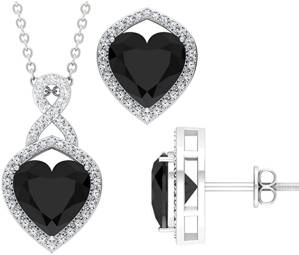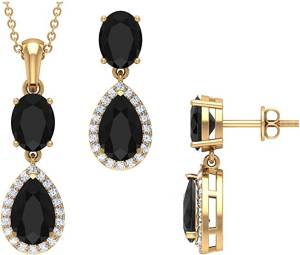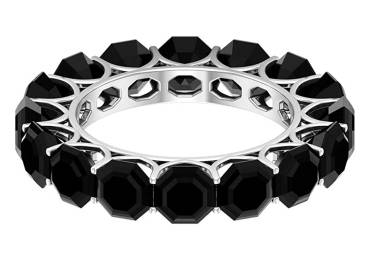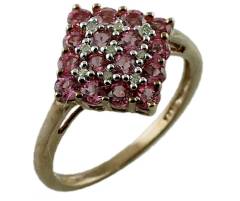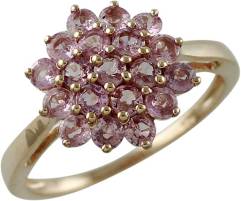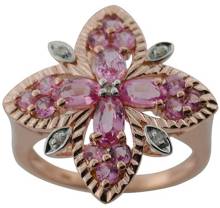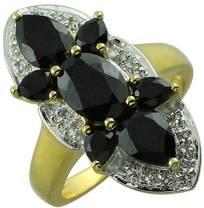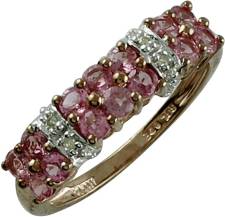Spinel is a gorgeous gemstone masqueraded as ruby for hundreds of years. It is a rare gemstone considered the zodiac stone for Gemini and related to the planet Mercury. This stunning gem is famous for its stark resemblance to Ruby.
Despite being used in jewelry since prehistoric times, we have only recently given Spinel the appreciation it deserves.
Gemstone Rare Blood Red Spinel Smooth Loose Rondelle Gemstone Craft Beads
Click On The Image
Since spinel is often found in the same mines as corundum, it was often mistaken for Ruby or Sapphire (the identification error got corrected after the advent of modern gemology late in the 19th century). Nonetheless, these minerals have different chemical compositions.
For instance, the centerpiece jewel in the Imperial State Crown of England, a 170 carat bright red stone, famously known as “The Black Prince’s Ruby,” is indeed a fine-looking Spinel. It is a Smoothly polished and roughly octagonal stone.
Another example is the “Timur Ruby” – a 352.5 carat bright red stone that adorns a necklace of the Royal Collection owned by Queen Elizabeth. It is once again the beautiful Spinel. Furthermore, several Persian inscriptions carved into this gemstone testify to its age and history.
Thus the great stone imposter impersonated ruby in royal jewels for centuries together.
Click On The Images
Following the revelation of the gem’s true identity, gem aficionados learned that their precious rubies and sapphires were in fact spinels. Consequently, the stone’s reputation suffered. Aside from that, we find a profusion of inexpensive synthetic Spinel in the jewelry trade. This lab-grown Spinel is commonly used as a substitute for other gems in jewelry pieces. As a result, the public perception of the gem suffered further.
Be that as it may, natural Spinel is a gorgeous gem. Further, people are also learning about the substantial and often-intrusive enhancements given to inferior quality Sapphire and Ruby to “fluff up” their color or clarity.
On the other hand, the color of Spinel does not improve with heat treatment. That being so, virtually all the Spinel available in the gem trade is untreated. As a consequence, enthusiasts of untreated natural gems have started appreciating Spinel’s natural beauty. The jewel is well known for its deep red variety.
Additionally, the reasonably low prices, the fact that they are available in many colors, and the fact that they can be matched with virtually any type of jewelry make them very appealing.
14K White Gold Black Spinel Eternity Rings for Women
Click On The Image
The name spinel is either derived from the Latin word “Spina,” which means thorn, owing to its pointed crystal form, or the Greek word for “Spark” for its bright color.
Properties of The Gem:
Spinel has an octahedral crystal structure and single refraction. Also, it is lower in hardness on the Mohs scale than Ruby and Sapphire.
Mineral: Spinel
Chemistry: MgAl2O4
Color: Red, Orange, Pink, Purple, Blue, Black
Refractive Index: 1.718
Birefringence: None
Specific Gravity: 3.60
Mohs Hardness: 8
Due to its exceptional hardness and high clarity, Spinel is an excellent gemstone for all types of jewelry. The gem is a collector’s item.
Gemologists classify Spinels into different varieties based on color.:
| Rubicelle or Flame | : | Bright Orange to Orange Red | |
| Balas | : | Pink to Pale Red | |
| Gahnite or Zinc | : | Blue to Violet and Dark Green to Deep Black | |
| Pleonaste or Ceylonite | : | Dark Green to Blackish. Opaque and Iron Rich | |
| Gahnospinel | : | Blue to Dark Blue or Greenish. Zinc rich | |
| Picotite or Chrome | : | Brownish | |
| Almandine | : | Violet to Violet Blue | |
| Ruby Spinel | : | Ruby Red Variety |
Amongst all of the above, Ruby Spinels are the most in-demand and considered more expensive than others. Also, lapidaries cut this stone into elaborate shapes like oval, square, octagon, etc.
Though jewelers do not treat or enhance this stone, synthetic variety is available in gems and jewelry. Therefore, one should be careful while buying this stone. Particular since Spinel comes at a relatively affordable price. The magnificence and affordability of this gemstone add to its USP.
We find deposits of this gemstone in Cambodia, Sri Lanka, Myanmar, Afghanistan, Tanzania, and Thailand. Gemstone mines of Central & South-East Asian regions yielded large gemstone crystals. These fine stones came to be called Balas rubies. A number of them were the treasures of emperors & kings. They often passed through many hands as spoils of war.
Click On The Images
The 4C Guide to Buying Spinel:
While buying, Spinel offers you a lot of colors for your choice. However, red, intense cornflower blue, and pink are the most popular and command the highest prices. Lilac and Mauve also have their own fan following.
Clarity and carat weight attributes also impact value significantly. A proven Myanmar provenance further enhances the stone’s appeal.
The Color Attribute:
The color grading system assigns three tiers to the color attribute. They are hue, tone, and saturation.
The primary hues are purple, red, orange, yellow, green, blue, violet, and purple.
Tone measures a color’s level of lightness or darkness. Its value ranges from colorless (denoted by 0) to black (indicated by 10).
Saturation indicates a color’s intensity. This scale ranges from grayish or brownish (denoted by 1) to vivid (represented by 6). Among the three tiers, color Saturation has the maximum impact on price.
Carillon Pink Spinel 10K Rose Gold Ring Unique Jewelry
Click On The Image
Red Color Spinels:
Vivid red is the most important color of Spinel. Its color resembles the pigeon blood red of Burmese ruby. While fine red Spinel is technically rarer than fine rubies, it is not as pricey.
The Flame Spinel: What is it?
The term’ flame spinels’ describes stones with a medium tone and intense saturation of an orange or orangey-red hue.
Blue and Violet Spinels:
Blue and violet spinels are generally less expensive, except if their color is highly saturated. Buyers prize cobalt-colored stones for their intense blue color.
Spinels Pretty in Pink:
Spinels in various pink hues are extremely popular among gemologists and gem connoisseurs. The neon-pinks from Tanzania, the bright “open” pinks, and the sweet pinkish-red “Jedi spinels” from Myanmar are among them.
Color Change Chameleon Spinels:
Color change Spinels transform from blues & greys in daylight to strong reddish-purple & pinks amethyst-like color in incandescent light. These rare phenomenal stones are greatly cherished.
Buyers consider pale to medium mauve-pink and light grayish purple the least desirable colors. Consequently, stones displaying these colors command the least value.
Click On The Images
The Clarity Attribute of Spinel:
In gemology, clarity corresponds to a gem’s transparency and factors that affect its ability to transmit light—for example, the presence or absence of inclusions. Unfortunately, gemstones are generally vulnerable to inclusions, and Spinel is no different.
Moreover, spinels are classified as Type II gems, indicating an inherently included gemstone. An inclusion-free spinel will command a hefty price. Likewise, the eye-clean stone also earns a premium. On the other hand, gems with prominent inclusions tend to be less valuable.
But, we already discussed that color saturation has the maximum impact on the prize. As such, a stone blessed with superior color attributes will overcome the presence of minute inclusions and still command a handsome premium. But, such stones are rare and costly. Furthermore, such quality stones in larger sizes above 3 carats are still scarcer.
Star Spinels and Cat’s Eye Spinels.:
Asterism is a phenomenon that enables a gem to show 4-ray, 6-ray, or even 8-ray star of light to appear and float on the gem’s surface. Such gems are called star gems.
Chatoyancy is yet another phenomenon by which a gem displays a thin band of light to appear on a gem’s surface. The band looks like a cat’s pupil under bright light. Consequently, such a gem is known as a cat’s eye gem.
Tiny, tightly packed, well-placed inclusions that reflect light in unison cause these phenomena. Such gems are cut into cabochons to enhance the effect. Both Star spinels and cat’s eye spinels occur in nature. But both are exceedingly rare and hence highly prized stones.
Spinel’s Cut Attribute:
Just like a diamond, Spinel too exists in nature in the form of gorgeous octahedron crystals. Lapidaries cut these Spinel crystals in a variety of cutting styles. The cutters also facet them into several shapes to accentuate their color and brilliance. Among them, ovals and cushions are very popular.
Cut quality impacts the appearance of a gem as well as its value.
Correctly proportioned, well-cut, and symmetrically faceted stones show more brilliance and look more beautiful. However, on account of the scarcity of Spinel, cutters sometimes try to save gem material and compromise on the cut quality. This practice yields larger stones but with less brilliance.
Carat Weight and Spinel:
The gemstone is also valued based on its size and weight. Large faceted stones are rare because large rough uncut spinel crystals seldom occur in nature. Consequently, price per carat takes a dramatic leap for fine quality red, blue, and pink facetted spinels once their weight crosses 3 to 5 carats.
The Synthetic Spinel:
Spinel does not respond well to heat treatment. As such, the process does not substantially improve its color. That being so, the natural Spinels available today can be assumed to be untreated.
Nevertheless, synthetic Spinels are widespread. These are the artificial counterparts of their natural versions. Labs can forge them easily by fusing constituents found in natural gemstones using the flame fusion method. The synthesized stones look very similar to the natural ones while they are relatively affordable. And they are extensively used in the jewelry sector.
A gemologist can tell if a stone is synthetic or natural by examining its absorption spectrum.
Geographical Origin of Spinels:
Emerald, rubies, lapis lazuli, and Spinel, are all found in Afghanistan. And they are known for their superior quality. Ancient cultures have mined pink-to-red Spinel in the Badakhshan region of eastern Afghanistan, near the Kuh-i-Lal mines of Tajikistan. And the excavation continues to the present day.
However, spinels mined from Afghanistan and Tajikistan were called rubies until the 19th century because of their color. These areas still give us Pink and red Spinel.
Spinels From Sri Lanka:
Today Sri Lanka is the principal source of gem-quality Spinel on the market. Ceylonite or pleonast is the Iron-rich, dark green Spinel from Sri Lanka. The zinc-rich, blue stone called gahno-spinel is also a typical Sri Lankan gemstone. The region also churns out the rare cobalt blue variety.
Those From Myanmar:
Myanmar has been the predominant supplier of the finest spinels for centuries. Miners dig out pink to red, orangey-pink to orangey-red, and grey to purplish-grey gem-quality Spinel from mines like Yadanar Kaday Kadar, Bawlongyi, Kyauksin, Kyauksaung, Pyaungpyin, and Mansin in the Mogok area. Here, poor people with inherited rights to excavate gems from mine tailings are called kanase women.
“Jedi Spinels”:
The neon-hot-pink to red “Jedi” spinel from Myanmar is experiencing a dramatic rise in demand in Asian markets. Vincent Pardieu, a distinguished field gemmologist, coined this name.
Prospectors mine this particular Spinel near Man Sin in Myanmar. Gem-enthusiasts fall in love with their intense, vibrant colors. Unfortunately, Jedi spinels larger than three carats are exceedingly rare. Those above five carats are virtually non-existent. As such, they are very pricey.
Tanzania:
Miners stumbled upon a massive pinkish-red spinel crystal of 52 kg at Ipangko south of Mahenge (Tanzania) in 2007. This chance discovery triggered a supply of vibrant pinkish-red and orangey-red spinels in the gem market. Moreover, Tanzania stones match those from Myanmar in beauty, color, and quality.
See More Gemstones As Follows
